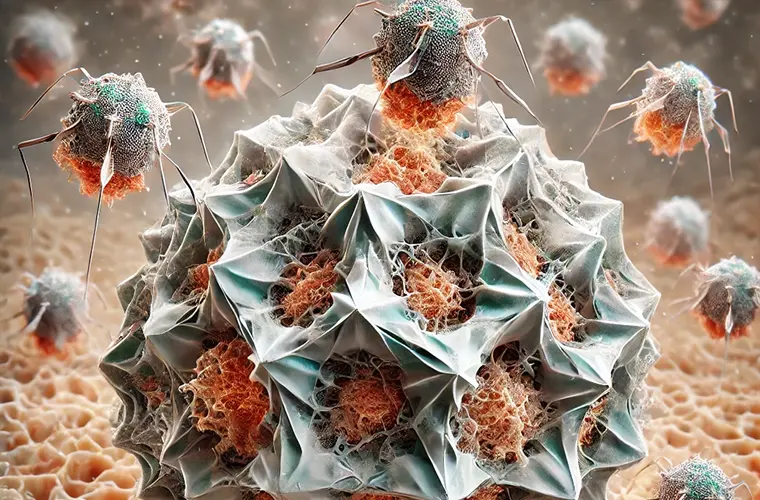In a groundbreaking advancement in cancer research, scientists at the Karolinska Institutet in Sweden have engineered nanorobots made from “DNA origami” capable of specifically targeting and eliminating cancer cells in mice.
This remarkable breakthrough, detailed in a study published today in Nature Nanotechnology, showcases the potential of nanotechnology to revolutionize cancer treatment and offers hope for future human applications.
Interestingly, the announcement follows renowned futurist Raymond Kurzweil’s recent bold prediction that advancements in nanorobot technology will soon extend the human lifespan to 1,000 years.
In his latest book, The Singularity is Nearer, released June 25, Kurzweil forecasts that by the 2030s, medical nanorobots, tiny robots that can operate at the molecular level, will allow humans to transcend the limitations of biological organs.
Kurzweil’s prediction, while ambitious, is increasingly looking like more of a reality as a team of releasers at Karolinska Institutet have developed nanorobots that can seek out and eliminate cancer cells with unprecedented precision while leaving surrounding healthy cells unharmed.
At the core of this breakthrough is the creation of nanoscale structures built with DNA, called DNA origami. Specifically, the nanobots’ three-dimensional DNA origami design allows them to be both pH-sensitive and capable of autonomous function.
The head of the nanorobot contains a cavity that physically hides six cytotoxic ligands arranged in a hexagonal pattern. These peptides are designed to bind to and activate death receptors on cancer cells.
Under normal physiological conditions, including environments with an acidic pH of 7.4, the ligands remain concealed within the nanorobot, rendering it inert and harmless. However, at a pH level of 6.5, typical of cancerous tissues, a “kill switch” is triggered, and the DNA structures unfold to reveal cytotoxic ligands. The ligands then cluster death receptors on the surface of cancer cells, triggering apoptosis or programmed cell death.
The DNA origami technique allows for precise control over the spatial arrangement of the ligands, ensuring optimal clustering of the death receptors, which is crucial for inducing effective cell death.
This level of precision in targeting and activating the death receptors sets this technology apart from conventional cancer treatments, which often lack such specificity and can result in significant side effects.
“This hexagonal nanopattern of peptides becomes a lethal weapon,” Dr. Björn Högberg, a professor of medical biochemistry and biophysics and lead study author, explained in a release by Karolinska Institutet. “If you were to administer it as a drug, it would indiscriminately start killing cells in the body, which would not be good. To get around this problem, we have hidden the weapon inside a nanostructure built from DNA.”
Nanorobots are essentially tiny robots, often no larger than a few nanometers, that can perform specific tasks within the body at the molecular level. In this case, the nanorobots are equipped with sensors and biochemical payloads designed to recognize and attack cancer cells.
Building nanorobots from DNA origami ensures the devices are biocompatible, meaning they can navigate the human body without causing adverse reactions.
Once administered, these DNA origami nanorobots travel through the bloodstream, homing in on cancer cells by detecting acidic pH levels unique to malignant tumors. Upon reaching their target, the nanorobots release a therapeutic agent that induces cell death, effectively eliminating the cancer cells.
In experimental trials with mice bearing human breast cancer xenografts, the breakthrough nanodevices demonstrated a significant reduction in tumor growth, achieving up to a 70% decrease. The impressive success of the DNA origami nanobots in mice paves the way for further research and potential clinical trials in humans.
The potential implications of this technology are profound. DNA origami nanobots could revolutionize how we treat cancer, offering a more targeted and less invasive alternative to current therapies. The ability to precisely target cancer cells while sparing healthy tissue could open up new avenues for cancer therapy, potentially leading to treatments that are more effective and less harmful than current methods such as chemotherapy and radiation.
Moreover, the principles underlying this technology could be applied to other diseases where targeted cell death is beneficial, such as certain autoimmune diseases and viral infections. DNA origami’s versatility and programmability make it a powerful tool in the development of next-generation medical treatments.
Despite the promising results, researchers caution that several challenges remain before this technology can be widely used in clinical settings. These include ensuring the stability and longevity of the nanorobots in the human body, scaling up the production of these nanostructures, and thoroughly testing for any unforeseen side effects.
“We now need to investigate whether this works in more advanced cancer models that more closely resemble the real human disease,” study co-author and researcher at the Department of Medical Biochemistry and Biophysics, Karolinska Institutet. Dr. Yang Wang explained. “We also need to find out what side effects the method has before it can be tested on humans.”
Researchers also plan to investigate the possibility of creating more targeted DNA origami nanobots that can bind exclusively to specific types of cancer. This could be achieved by altering the arrangement of proteins or peptides on the device’s surface.
If successful, this technology could be a game-changer in oncology, providing a new, highly effective tool for combating one of humanity’s most persistent health challenges.
The breakthrough could also mark the beginning of numerous nanotechnologies that might lead to a future envisioned by Raymond Kurzweil, where humanity’s survival is no longer constrained by biological limitations.
Tim McMillan is a retired law enforcement executive, investigative reporter and co-founder of The Debrief. His writing typically focuses on defense, national security, the Intelligence Community and topics related to psychology. You can follow Tim on Twitter: @LtTimMcMillan. Tim can be reached by email: tim@thedebrief.org or through encrypted email: LtTimMcMillan@protonmail.com

